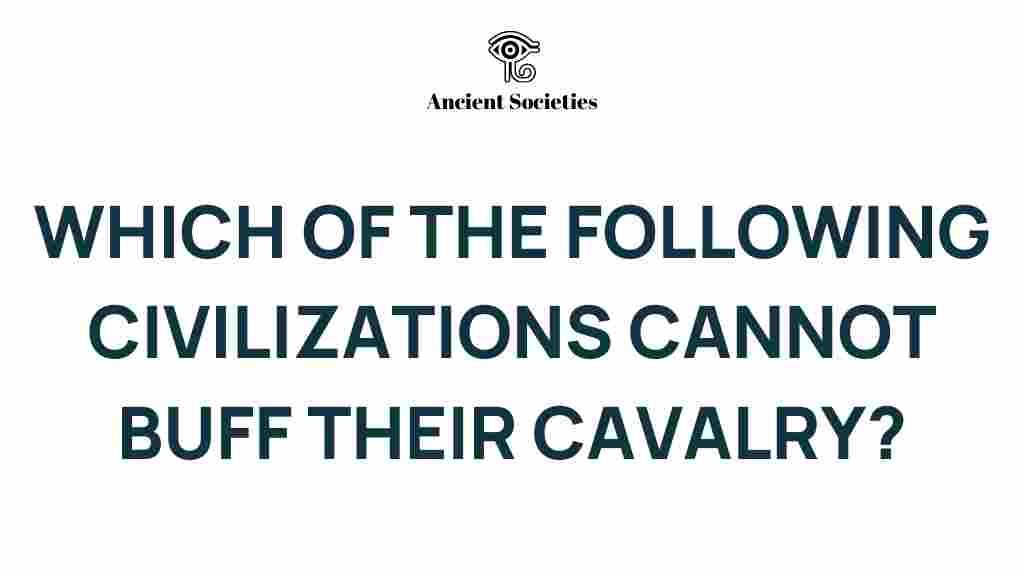Unraveling the Mysteries: Which Civilizations Lacked Cavalry Buffs?
The study of civilizations throughout history reveals a diverse tapestry of cultures, innovations, and military tactics. One of the most significant aspects of ancient military history is the role of cavalry in strategic warfare. While many empires harnessed the power of horsemen to gain an advantage on the battlefield, not all civilizations incorporated cavalry into their military arsenals. This article delves into the civilizations that lacked cavalry buffs, examining their unique military strategies, cultural advancements, and the implications of their choices on their historical trajectories.
Civilizations and the Role of Cavalry in Military History
Cavalry has been a critical component of military history, providing speed, mobility, and shock value in battles. However, the adoption and effectiveness of cavalry varied among different civilizations. Some cultures excelled in mounted warfare, while others relied on infantry or other forms of combat. Understanding which civilizations lacked cavalry buffs requires a look at their tactical choices and the environmental factors that influenced them.
The Importance of Cavalry in Ancient Empires
In many ancient empires, cavalry units were essential for a range of military operations, including:
- Scouting: Cavalry units could quickly gather intelligence on enemy movements.
- Flanking Maneuvers: Horsemen could outmaneuver infantry, attacking from the sides or rear.
- Rapid Pursuit: Mounted troops could chase down fleeing enemies or reinforce critical points swiftly.
However, not every civilization embraced these advantages. Below, we explore some notable examples of civilizations that lacked cavalry buffs.
Step-by-Step Analysis of Civilizations Lacking Cavalry Buffs
1. The Early Mesopotamians
While the Mesopotamian civilizations, such as the Sumerians and Akkadians, are often credited with numerous advancements, they primarily relied on infantry. Their military strategies focused on:
- Phalanx Formation: Sumerian armies utilized dense formations of foot soldiers wielding spears and shields.
- Siege Warfare: They invested in building fortifications and employing siege tactics against rival city-states.
The geography of Mesopotamia, characterized by marshy areas and rivers, made cavalry less effective compared to other terrains.
2. The Indus Valley Civilization
The Indus Valley Civilization (IVC), known for its advanced urban planning and trade networks, lacked evidence of cavalry. Their military strategies included:
- Fortified Cities: Cities like Mohenjo-Daro and Harappa featured robust defenses, suggesting an emphasis on static defense.
- Infantry Warfare: The IVC likely relied on foot soldiers equipped with bows, slings, and other ranged weapons.
Environmental factors, including the region’s topography, may have influenced their military tactics, favoring infantry over cavalry.
3. The Ancient Egyptians (Early Periods)
While later periods of ancient Egyptian history saw the introduction of chariots and horsemen, early dynasties heavily relied on infantry. Their military organization included:
- Archers: Egyptian foot soldiers frequently used bows, taking advantage of their range and precision.
- Shield Bearers: Infantry formations often included soldiers equipped with shields to protect archers.
The reliance on infantry in the early periods of Egyptian history illustrates a gradual evolution of military tactics as the empire expanded and encountered new threats.
Tactics and Cultural Advancements
Despite their lack of cavalry, these civilizations were not without their cultural advancements and strategic ingenuity. The following aspects highlight how they adapted their military tactics:
- Innovative Weaponry: Many civilizations developed advanced weaponry, such as bronze swords and composite bows, which enhanced their infantry’s effectiveness.
- Logistics and Supply Chains: Effective supply lines and resource management were crucial for sustaining long campaigns.
- Diplomacy and Alliances: Forming alliances with neighboring tribes or cities often mitigated the need for cavalry by pooling resources and military strength.
Historical Analysis of Non-Cavalry Civilizations
Understanding why certain civilizations did not develop cavalry units involves analyzing their historical context. Key factors include:
1. Geography
The physical landscape played a significant role in shaping military tactics. Civilizations with dense forests, mountainous regions, or marshlands often found cavalry less practical. For instance, the thick jungles in parts of Southeast Asia limited the mobility of horsemen.
2. Economic Factors
Maintaining a cavalry force requires substantial resources, including food for horses, specialized equipment, and training. Civilizations prioritizing agriculture or trade over military expansion might have opted for more cost-effective infantry forces.
3. Cultural Attitudes
In some cultures, there was a strong emphasis on infantry warfare as a reflection of social values. For example, the honor associated with foot soldiers in certain societies influenced their military structure, leading to a neglect of cavalry.
Troubleshooting Tips for Understanding Military History
When researching and analyzing civilizations and their military tactics, consider the following tips:
- Cross-reference Sources: Utilize multiple historical texts and archaeological findings to gain a more comprehensive view.
- Contextualize Findings: Always consider the geographical, economic, and cultural context of the civilization in question.
- Examine Evolution: Analyze how military tactics evolved over time, particularly in response to external threats or internal changes.
For further insights into military history and the evolution of tactics, you can explore additional resources.
Conclusion
In conclusion, while cavalry played a decisive role in the military strategies of many ancient empires, several civilizations opted for alternative approaches to warfare. The early Mesopotamians, Indus Valley Civilization, and early Egyptians are prime examples of cultures that lacked cavalry buffs. Their reliance on infantry, innovative tactics, and cultural advancements allowed them to thrive despite the absence of mounted warriors.
By unraveling the mysteries surrounding these civilizations, we gain a deeper understanding of military history and the diverse strategies that shaped our world. Each civilization, with its unique context and challenges, contributed to the rich tapestry of human history, reminding us that there is much to learn from their choices and adaptations.
For a deeper dive into the impact of cavalry on military strategies throughout history, consider visiting historical analysis websites that specialize in ancient military tactics.
This article is in the category History and created by AncientSocieties Team
